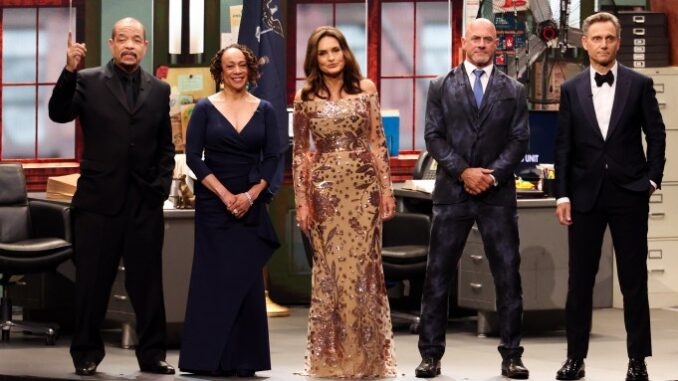
Did You Catch Benson’s Blink and You’ll Miss It Nod to Stabler on Law & Order SVU?
In the cacophony of urgent voices, the flashing lights, and the ever-present hum of New York City’s relentless crime, television narratives often thrive on the grand gesture, the explosive confrontation, or the dramatic monologue. Yet, for the truly dedicated viewer, for those who breathe the oxygen of a long-running series, it is often the whisper, the glance, the blink-and-you’ll-miss-it subtlety that resonates deepest, telling a story far richer than any shouted declaration. Such is the power of a brief, almost imperceptible nod exchanged between Olivia Benson and Elliot Stabler on Law & Order: SVU – a micro-moment that speaks volumes about an enduring bond, the art of subtext, and the profound language of silence.
To truly appreciate the gravitas of such a fleeting gesture, one must first understand the decades-long history that precedes it. Olivia Benson and Elliot Stabler were, for twelve seasons, the unbreakable heart of the Special Victims Unit. Their partnership transcended the typical precinct camaraderie, forged in the crucible of unspeakable crimes, shared traumas, and an unspoken, yet palpable, emotional intimacy that simmered just beneath the surface of their professionalism. They were two halves of a whole, reading each other’s thoughts, anticipating each other’s moves, and offering silent solace in the face of humanity’s darkest corners. Stabler’s abrupt departure after Season 12 left a gaping wound in Benson’s life, and in the hearts of millions of viewers, creating a void that no amount of subsequent excellent casting could entirely fill. His eventual return, a decade later, wasn’t just a narrative plot point; it was a reunion of seismic emotional proportions.
It is against this backdrop of shared history, abrupt separation, and a long-awaited reconciliation that Benson’s subtle nod takes on its monumental weight. Imagine the scene: a tense interrogation room, a volatile suspect, or a frantic crime scene. The plot is hurtling forward, dialogue is sharp and purposeful, and the camera is typically focused on the central action, the prime suspect, or the crucial piece of evidence. Stabler, back in the fold, might be delivering a crucial piece of information, taking control of a situation, or simply standing by, a silent sentinel of strength.
And then, it happens.
It’s not a full turn of the head, not a lingering gaze, certainly not a wide smile or a spoken word of affirmation. It’s a fraction of a second: a quick dart of Benson’s eyes towards Stabler, a slight dip of her chin, almost imperceptible to the casual observer, perhaps even mistaken for a natural twitch or a shift in focus. It’s so quick that if you were to blink, you would genuinely miss it. The expression on her face might not even change, remaining a mask of professional intensity or carefully controlled emotion. Yet, for those who have watched their story unfold for decades, for those who understand the secret language they’ve developed over years of shared silence and knowing glances, that nod is a complete sentence.
What does this blink-and-you’ll-miss-it nod communicate? Everything.
Firstly, it’s a profound affirmation of trust and understanding. In that fleeting moment, Benson is silently saying, “I’ve got your back,” or “I know exactly what you’re thinking,” or even, “You’re still the one I rely on.” It’s a shorthand born of years, bypassing the need for verbal confirmation. It reassures both Stabler within the narrative and the viewer outside of it that their partnership, though changed by time and circumstance, remains fundamentally intact.
Secondly, it speaks to their unique history. The nod is a private communication in a public space, a micro-moment that acknowledges a shared past no one else can fully comprehend. It’s a whisper between them that only they—and the hyper-attuned audience—can decipher. It harkens back to every dangerous situation they navigated, every perpetrator they confronted, every time they stood shoulder-to-shoulder against the world.
Finally, and perhaps most poignantly, it illustrates the enduring emotional resonance of their connection. Despite their individual evolutions, despite Stabler’s new path on Organized Crime, despite Benson’s growth into Captain, that nod signifies an unbroken thread. It’s a confirmation that the gravitational pull between them, that deep well of affection and respect, persists. It hints at the unresolved tension, the unspoken feelings, and the profound depth of a relationship that continues to evolve, even when not explicitly the focus of the scene.
For the millions who have invested decades of emotional capital into the partnership of Olivia Benson and Elliot Stabler, these fleeting glimpses are not just narrative embellishments; they are validations, rewards for their unwavering loyalty. They are the cinematic equivalent of an inside joke, a secret handshake, making the viewer feel privy to a sacred intimacy. These “blink and you’ll miss it” moments are precisely why Law & Order: SVU continues to captivate: it understands that the loudest stories are often told in the quietest ways, and that a single, almost imperceptible nod can carry the weight of a twenty-year legacy. It is in these moments of subtle grace that the true artistry of long-form television storytelling truly shines.
